| enter keyword to search: |
|
Images db
|
|
|
Articles db
|
|
|
|
|
|
|
| Udaigiri and Khandagiri caves |
|
Just 7 km west of Bhubaneswar in the twin hills of Khandagiri and Udayagiri in a relative small area there are a number of gumpha, monastic rock-cut dwellings excavated during the ii c BC - i c AD by the Jains.
As you approach the site, Khandagiri ('Broken Hill') will be on the left and Udayagiri ('Sunrise Hill'), which with its 18 caves has the finest stonework, will be on the right.
The small cells open into pillared veranda with their facades encrusted with friezes and pillar capitals that, although carved in coarse sandstone, show Orissan art at an early stage with complex tales that testify the rich, now lost, literary tradition of the early Jains.
Udaigiri |
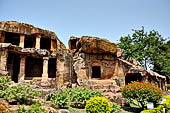
|
Udaigiri
(alternative spelling Udaygiri Udayagiri) Soon after the entrance gate past the log stairway leading to the top of the hill you will see at your left a gardened area with the first group of interesting caves numbered by the Archaeological Survey of India (ASI) n° 4 and n° 3.
Cave n° 4 – ‘Alakapuri Gumpha’ is a two storied cave with an entrance cell reachable with a flight of steps. The entrance cell has on one side a dvarapala and on the other a surasundari holding a bird in her hand, inside there are various sculptures like winged lions, a lion holding his prey, elephants and so on.
Cave n° 3 – ‘Chota Hati Gumpha’ (Small Elephant Cave) is a small cell with a low ceiling originally provided with a single wooden door. The façade of the cave is decorated with six remarkable elephant figures, plants & floral motifs, pilaster are crowned with winged animal.
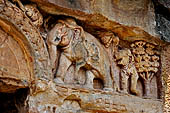
|
Udaigiri
|
The Queen Cave (Cave n° 1) - Further on, the path bends to the left rounding the base of the hill and you will reach the famous Rani Gumpha, 'Rani ka Naur' or 'Queen's Cave', the largest and more elaborate cave. The two storied main facade and two wings are arranged around the three sides of an open courtyard.
At each corner there is a small pavilion, called 'guard station' decorated with nature scenes, elephants, birds and trees with fruits. The scene on the eastern wall of the southern pavilion represents hill rocks and forest with fruit tree and elephants enjoying a bath. Two armed dvarapalas guard either side of the wings.
Udaigiri |
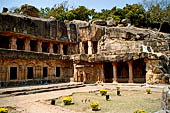
|
The frieze of the abduction of a woman of the upper storey - The interspaces between the projecting arches of the cells are occupied with bas-reliefs. The reliefs have not been identified but a local legend narrates the story of a Kalinga princess carried away by Ashoka after the Kalinga battle. The friezes are described from the right end of the upper storey.
The first tableau represents a running figure running with a tray in one hand.
In the second tableau three elephants are represented fighting with a group of persons.
The third tableau represents a combat between a man (the prince) and a woman (the princess), each armed with swords and oblong shields while on the right a warrior is carrying off an amazon (the abduction of the defeated princess).
The forth tableau is the hunt. Followed by his horse and attendants, the prince, standing behind a tree, has just shot an arrow at a winged animal. To the right the king is represented again bow in hand with the prey lying below a tree in which a naked woman is seated among the branches.
The following tableaux are very much effaced and only the scene adjoining the forth door it seems to represent a bacchanalian scene. A huge male figure is seated attended by women, to the right a group of musicians sits in front of female dancers, but the figures are so defaced that their interpretation is difficult.

|
Udaigiri
|
The friezes of the ground floor. The first from left (south) shows a two storied dwelling with human figures looking out from the windows a high tree grows by the side. All the other friezes are very weathered and only the friezes of the archway of the northern corner can still be seen. On the left of the archway there is a group of nine persons, two of them are kneeling, other are carrying offers and an attendant holds an umbrella. On the left of the archway a horse and three figures are represented, while on the other side there is a group of persons with a sword and a third one is carrying and umbrella over the king and, finally, further on the right side a women carrying offerings.
The friezes of the veranda of the left wing of the ground floor. The first tableau from left contains a man, two women and a dwarf, one of the women carrying offerings and the other two standing in the attitude of reverence. Women wear heavy rings as anklets.
The second tableau represents a seated man between two women in the attitude of adoration and other two women holding offerings. Finally the third tableau represents a nautch (Indian traditional dance) performed by a girl under an ornamented canopy and other women playing musical instruments. The last scene contains three figures one is the raja with a plumed head dress followed by his wife and a child.
Udaigiri |
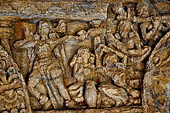
|
Going up the hill at the top of the stairway to the right we find the two storied Cave 9 (Manchapuri Cave). A Buddhist railing runs at the top of the lower veranda, inside the relief between the second and third door shows the worshipping of the legendary Kalinga Jina a long-vanished Jain symbol. The one wearing a crown (second from the left) is thought to be the Chedi king, Vakradeva, whose donative inscription can still be seen near the roof (the identification is not certain).
To reach Ganesh Gumpha (Cave n° 10), from the top of the main steps walk to the right and around the top of the hill.
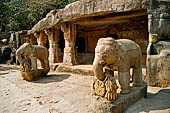
|
Udaigiri
|
In front of Ganesh Gumpha there are two massive elephants, the first example in India of sculptured animals used to guard a temple entrance. The cave consists of two cells with four doors and a veranda. Inside the right cell there is one of the earliest image of Ganesha (early fifth century). In the interspaces of the door archways there are two bas-reliefs.
The first bas-relief (from the right) consists of four episodes: in the first scene four warriors are pursuing three persons mounted on an elephant, note that the one on the elephant which is cutting off the head of his enemy. In the next scene the three people has dismounted from the elephant which is kneeling. In the following scene the woman puts her hand on the warrior shoulder, finally in the last scene the woman is half reclining and the warrior is consoling her. It is impossible to say whether this scene illustrates a Jataka or some lost Orissan legend.
The second bas-relief is a repetition of the abduction scene seen on the Queen Cave with the difference of the couple with the reclining man on the far left, the rest of the scenes are the same. Note the band around the tympana coming out the mouth of fabulous animals like a crocodile, an elephant or a fish, a decorative motif this one that will become frequent in all south-east Asia.
From here, follow the path up to the very top of the hill where there ar the ruins of an old chaitya hall, probably the place of worship for the legendary Kalinga Jina.
From here the path goes down to the main stairs passing by the Cave 12 Tiger cave (Bagh Gumpha), shaped like the head of a tiger, and Cave 14 Hathi Gumpha (Elephant cave) known for the ancient inscription (I c. BC - I c. AD).
Udaigiri |
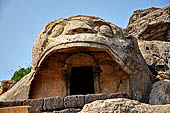
|
Khandagiri
The entrance to the Khandagiri caves on the opposite hill is just in front of the main entrance (ticket office). Instead of climbing the steps crowded with pilgrims and monkeys we headed right at the base of the hill and soon we reached the Tatowa Gumpha Caves n° 1 and n° 2 , known as the 'Parrot Caves' for the carvings of birds on their doorway-arches. The verandah of Cave 2 is spacious and the decoration of arches of the cell doorways are more elaborate and have on either side doves and parrots. Projecting from the pillars supporting the ceiling of the verandah a brackets relieved with a dancer with a musician playing under a tree and another one with a female devotee holding a tray of flowers.
Further above the Tentuli Gumpha Cave n° 4 (ASI).
At the top of the hill the modern Jain temple with views across the plains.

|
Khandagiri
|
| |
|
|
 |
|
|



